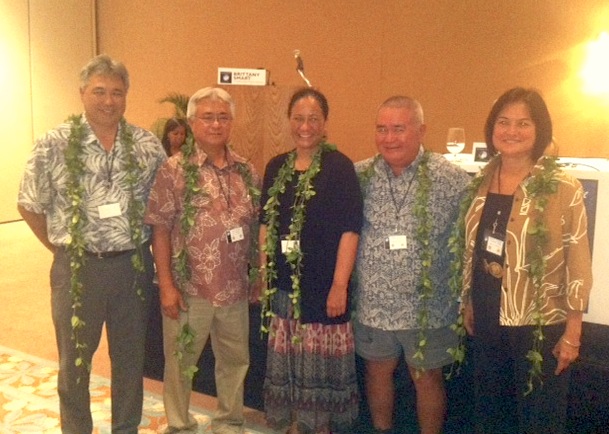Richard Ha writes:
I recently participated in a panel discussion at the Hawaii State Association of Counties conference, which was held at the Hapuna Prince Hotel. I was on the Renewable Energy panel to present the farmer’s point of view.
Here’s what I talked about:
I have attended four Association for the Study of Peak Oil (ASPO) conferences on the mainland. I went to learn about oil so I could position our farm business for the future. The most important thing I learned from my first trip was that the world had been using twice as much oil as it had been finding for the last 20 to 30 years. Clearly this was not good, and would have consequences.
A concept I picked up was Energy Return on Investment (EROI), sometimes called EROEI – Energy Returned on Energy Invested. It answers the question: What is the net energy left over after energy is used to get it? Said another way, the energy left over to get energy minus the energy it takes to get your food gives you your lifestyle.
In the 1930s, getting 100 barrels of oil took the energy of 1 barrel.
In the 1930s, 100 to 1
In the 1970s, 30 to 1
Now, it’s approximately 10 to 1
Canadian tar sands is 5 to 1
Biofuels is 2 to 1 (or less)
It takes approximately 6 to 1 to maintain our present, oil-based infrastructure.
Hot steam geothermal, like we have on the Big Island, might be 15 to 1. And its EROI will not decline for 500,000 years. Very few in the world are so fortunate.
Carl Bonham, head of UH Economic Research Organization (UHERO), was in Hilo recently for a Bank of Hawaii presentation. I asked him: If we were to use geothermal as our primary electrical base power for the Big Island, would we become more competitive to the rest of the world? He said yes.
Geothermal benefits all Big Islanders, from the rubbah slippah folk to the shiny shoe ones. It means more jobs and more money in people’s pockets.
What about growing biofuel?
Biofuel is traded on the world market. So we are in competition with producers the world over. The bottom line is that the producer with the best competitive advantages will have the most competitively priced product. When growing fuel crops, the best set of circumstances occurs when the production is concentrated an equal distant from the processing plant. A circular model works best. Intense sun energy, flat land and deep fertile soil with good irrigation gives one good advantages. These qualities rarely occur on the Big Island at the scale necessary for our farmers to compete on the world market.
What about small agriculture? When oil is $100 per barrel, each pound of that oil is worth 38 cents. If a farmer needs to grow 4 pounds of stuff to squeeze out 1 lb. of liquid, the most that farmer can expect is 9 and 1/2 cents per pound to grow the stuff.
Everything being equal, any farmer would prefer to grow something that makes more than 9 and 1/2 cents per pound.
Several years ago on the mainland, there were cellulosic biofuel projects that needed farmer-grown feedstock that cost no more than $45 per ton. But farmers were getting $100 per ton for hay. So they received a subsidy of $45 per ton.
In spite of that, and many many millions of dollars of subsidies, there is still no successful cellulosic biofuel project In Hawaii, farmers get $200 to $300 for hay. It’s unlikely they would choose to grow something for half the return. It’s all about numbers.
What about Big Island biodiesel? Although it’s challenging, I do think they have the best chance of enabling farmer-grown biofuels. They have a model that works. All they have to do is tell farmers the form they want the product delivered to them and the price they will pay. Enterprising farmers will figure it out.
What can we do to help farmers make money? We can start with affordable electricity. And there is nothing more affordable than geothermal. On the Big Island, it costs 21 cents per kilowatt hour to generate electricity from oil. It costs half that to generate electricity from geothermal. While the price of oil will keep on rising, geothermal energy will stay stable for hundreds of thousands of years.
Farmers and ranchers incur costs associated with refrigeration at the processing plants, the distribution system, retailers and home refrigerators. If farmers and ranchers have lower costs, they can compete more successfully against mainland imports. And if their customers have more money in their pockets, they can support locally grown foods.
Food security and fuel are closely tied together. Food security involves farmers farming. And if farmers make money, farmers will farm.


So would you support our island taking a bio-fuels approach to agriculture to prop up our military at $26 a gallon? You talk so much about fuel prices, but is that not the ultimate price hike? Don’t you think maybe we should take a more traditional approach to agriculture? This is just silly.
Why do you conclude that I support $26 per gallon biofuel? It is obvious to me that $26 per gallon biofuel needs to be subsidized and is therefore unsustainable. That is equal to $1,092 per barrel. Of course it’s silly. But, do I support research to keep on driving the cost down? The answer is yes.
I have to agree, i think the price creates an environment for farmers to rather grow fuel than food, though i really like incorporating the ranchers for stock, this should foster our island beef, but my point is that farmers would rather have the higher price than farm food for the island. It seems to me it is feeding the monster we have already created here in Hawaii where growing profit crops is better than growing food for the island and state.